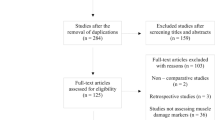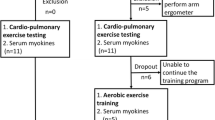Abstract
Muscle strength is of importance for postsurgical rehabilitation. Myostatin is a growth factor that regulates the size of muscles and could thus influence muscle mass and function in the postsurgical period. The aim of the present study was to study the changes in myostatin levels during the postsurgical inflammatory period. Myostatin was analysed in serum samples from two elective surgery groups, orthopaedic surgery (n = 24) and coronary bypass patients (n = 21). The samples were collected prior to surgery and 4 and 30 days after surgery. In the orthopaedic group, the median myostatin levels decreased from 3582 ng/L prior to surgery to 774 ng/L at day 4 (p < 0.001) and to 2016 ng/L at day 30 (p < 0.001). Median CRP increased from 2.35 mg/L preoperatively to 117 mg/L at day 4 and decreased to 5.5 mg/L at day 30 in the same group. The coronary bypass group showed a similar pattern with a decrease in myostatin from 4212 ng/L to 2574 ng/L at day 4 (p < 0.001) and to 2808 ng/L at day 30 (p = 0.002). Median CRP increased from 1.80 mg/L preoperatively to 136 mg/L at day 4 and returned to 6.12 mg/L at day 30 in the coronary bypass group. There was a significant decrease in myostatin concentrations both in the early and late postsurgical period. The lowest myostatin concentration time point coincided with the highest CRP concentration time point.

Similar content being viewed by others
REFERENCES
Elliott, B., D. Renshaw, S. Getting, and R. Mackenzie. 2012. The central role of myostatin in skeletal muscle and whole body homeostasis. Acta Physiologica (Oxford) 205: 324–340.
Huang, Z., X. Chen, and D. Chen. 2011. Myostatin: a novel insight into its role in metabolism, signal pathways, and expression regulation. Cellular Signalling 23: 1441–1446.
Joulia-Ekaza, D., and G. Cabello. 2007. The myostatin gene: physiology and pharmacological relevance. Current Opinion in Pharmacology 7: 310–315.
Smith, R.C., and B.K. Lin. 2013. Myostatin inhibitors as therapies for muscle wasting associated with cancer and other disorders. Current Opinion in Supportive and Palliative Care 7: 352–360.
McFarlane, C., E. Plummer, M. Thomas, A. Hennebry, M. Ashby, N. Ling, H. Smith, M. Sharma, and R. Kambadur. 2006. Myostatin induces cachexia by activating the ubiquitin proteolytic system through an NF-kappaB-independent, FoxO1-dependent mechanism. Journal of Cellular Physiology 209: 501–514.
Amirouche, A., A.C. Durieux, S. Banzet, N. Koulmann, R. Bonnefoy, C. Mouret, X. Bigard, A. Peinnequin, and D. Freyssenet. 2009. Down-regulation of Akt/mammalian target of rapamycin signaling pathway in response to myostatin overexpression in skeletal muscle. Endocrinology 150: 286–294.
Amthor, H., and W.M. Hoogaars. 2012. Interference with myostatin/ActRIIB signaling as a therapeutic strategy for Duchenne muscular dystrophy. Current Gene Therapy 12: 245–259.
Tsuchida, K., M. Nakatani, A. Uezumi, T. Murakami, and X. Cui. 2008. Signal transduction pathway through activin receptors as a therapeutic target of musculoskeletal diseases and cancer. Endocrine Journal 55: 11–21.
Liu, C.M., Z. Yang, C.W. Liu, R. Wang, P. Tien, R. Dale, and L.Q. Sun. 2007. Effect of RNA oligonucleotide targeting Foxo-1 on muscle growth in normal and cancer cachexia mice. Cancer Gene Therapy 14: 945–952.
Costelli, P., M. Muscaritoli, A. Bonetto, F. Penna, P. Reffo, M. Bossola, G. Bonelli, G.B. Doglietto, F.M. Baccino, and F.F. Rossi. 2008. Muscle myostatin signalling is enhanced in experimental cancer cachexia. European Journal of Clinical Investigation 38: 531–538.
Jeanplong, F., J.J. Bass, H.K. Smith, S.P. Kirk, R. Kambadur, M. Sharma, and J.M. Oldham. 2003. Prolonged underfeeding of sheep increases myostatin and myogenic regulatory factor Myf-5 in skeletal muscle while IGF-I and myogenin are repressed. Journal of Endocrinology 176: 425–437.
Reardon, K.A., J. Davis, R.M. Kapsa, P. Choong, and E. Byrne. 2001. Myostatin, insulin-like growth factor-1, and leukemia inhibitory factor mRNAs are upregulated in chronic human disuse muscle atrophy. Muscle & Nerve 24: 893–899.
Griffiths, R.D., and J.B. Hall. 2010. Intensive care unit-acquired weakness. Critical Care Medicine 38: 779–787.
Rudis, M.I., B.J. Guslits, E.L. Peterson, S.J. Hathaway, E. Angus, S. Beis, and B.J. Zarowitz. 1996. Economic impact of prolonged motor weakness complicating neuromuscular blockade in the intensive care unit. Critical Care Medicine 24: 1749–1756.
Seneff, M.G., D. Wagner, D. Thompson, C. Honeycutt, and M.R. Silver. 2000. The impact of long-term acute-care facilities on the outcome and cost of care for patients undergoing prolonged mechanical ventilation. Critical Care Medicine 28: 342–350.
Douglass, J.A., D.V. Tuxen, M. Horne, C.D. Scheinkestel, M. Weinmann, D. Czarny, and G. Bowes. 1992. Myopathy in severe asthma. The American Review of Respiratory Disease 146: 517–519.
Smith, I.J., Z. Aversa, N. Alamdari, V. Petkova, and P.O. Hasselgren. 2010. Sepsis downregulates myostatin mRNA levels without altering myostatin protein levels in skeletal muscle. Journal of Cellular Biochemistry 111: 1059–1073.
Elkasrawy, M., D. Immel, X. Wen, X. Liu, L.F. Liang, and M.W. Hamrick. 2012. Immunolocalization of myostatin (GDF-8) following musculoskeletal injury and the effects of exogenous myostatin on muscle and bone healing. The Journal of Histochemistry and Cytochemistry 60: 22–30.
Kellum, E., H. Starr, P. Arounleut, D. Immel, S. Fulzele, K. Wenger, and M.W. Hamrick. 2009. Myostatin (GDF-8) deficiency increases fracture callus size, Sox-5 expression, and callus bone volume. Bone 44: 17–23.
Hamrick, M.W., P. Arounleut, E. Kellum, M. Cain, D. Immel, and L.F. Liang. 2010. Recombinant myostatin (GDF-8) propeptide enhances the repair and regeneration of both muscle and bone in a model of deep penetrant musculoskeletal injury. Journal of Trauma 69: 579–583.
Mendias, C.L., E.B. Lynch, M.E. Davis, E.R. Sibilsky Enselman, J.A. Harning, P.D. Dewolf, T.A. Makki, and A. Bedi. 2013. Changes in circulating biomarkers of muscle atrophy, inflammation, and cartilage turnover in patients undergoing anterior cruciate ligament reconstruction and rehabilitation. American Journal of Sports Medicine 41: 1819–1826.
ACKNOWLEDGMENTS
This study was supported by the Uppsala University Hospital Research Fund.
Conflict of Interest
All authors declare that they have no conflict of interest.
Author information
Authors and Affiliations
Corresponding author
Rights and permissions
About this article
Cite this article
Åkerfeldt, T., Helmersson-Karlqvist, J., Gunningberg, L. et al. Postsurgical Acute Phase Reaction is Associated with Decreased Levels of Circulating Myostatin. Inflammation 38, 1727–1730 (2015). https://doi.org/10.1007/s10753-015-0149-6
Published:
Issue Date:
DOI: https://doi.org/10.1007/s10753-015-0149-6




